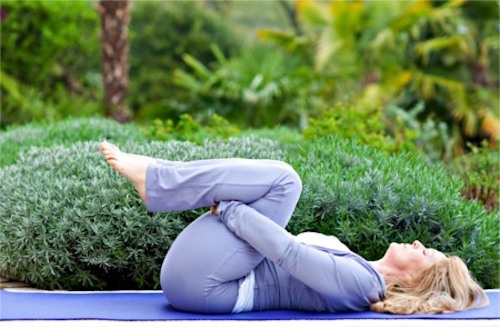Yoga can be for anyone. And there’s also a whole bouquet of wonderful kinds of yoga to choose from — something for everyone. Don’t let that variety of choices overwhelm you. Checking out a few can help you discover which type best connects you to your body, breath and mind, and helps you center.

Consider that one or two, or even three types might resonate with you and complement one another. You might like a vigorous practice at the beginning of the week, for example, but really yearn for something more relaxing by the time Friday rolls around. So let’s explore your options.
Type 1: Hatha yoga

Hatha yoga originally meant the physical practice of yoga, both asana (postures) and breath work (pranayama). Most yoga studios that offer the physical practice fall under the umbrella of Hatha Yoga. However, if you see a class or studio labeled Hatha, expect a slower pace. The physical postures and breathing exercises will be taught in a classic, and basic, approach.
Type 2: Iyengar yoga

Iyengar yoga focuses specifically on proper physical alignment within the postures. B.K.S. Iyengar introduced and popularized the use of yoga props — blocks, straps, blankets, bolsters, chairs, etc. These help yogis achieve a state of supported alignment.
An Iyengar yoga class is slow, precise and methodical. You will not jump or flow between the postures, but instead will be challenged to hold, breathe and explore the very deep inner and precise arrangement of the body within the shapes. Though slower in pace, Iyengar is challenging physically and mentally.
Is it for you? Iyengar yoga is great for beginners who want to understand the foundations of the asana. It’s also well-suited to those with injuries or limitations.
Type 3: Ashtanga yoga
Ashtanga yoga is guaranteed to make you move, breathe and sweat. The practice begins with 10 rounds of Sun Salutations, followed by a specific set and order of poses.
The Ashtanga practice is broken down into 6 series: primary, intermediate and four advanced. Traditionally, students must “master” a posture before the instructor allows them to proceed to the next step in the series. A typical Ashtanga class is usually offered as a primary series. Expect to do the same postures for the same number of breaths, during which endurance and strength are cultivated.
Is it for you? Ashtanga focuses less on alignment and more on rhythm and breath count. If you like to flow, sweat and know exactly what to expect, this might be the class for you.
Type 4: Vinyasa yoga

Vinyasa, often described as “flow” yoga, has become one of the most popular forms of Hatha yoga all over the world.
Vinyasa, like Ashtanga, involves dynamic and fluid transitions between the postures, linked specifically to breathing. But unlike Ashtanga, Vinyasa is taught and practiced in a never-ending variety of ways. It takes inspiration from all yoga lineages. Expect different sequences almost every time, often accompanied by a playlist of music.
Is it for you? If you enjoy a little creativity and variety, with alignment cues from an instructor, Vinyasa may be where you find your best flow.
Type 5: Bikram yoga
Bikram is practiced in rooms intentionally heated to 105 degrees. It’s similar to Ashtanga yoga in that it offers the same set and order of postures each and every time. However what makes Bikram yoga unique is that you do the same given 26 poses each time, and you do them twice.
Is it for you? If you like to sweat a lot and know exactly what is coming, this might be something you try. But it’s probably not a good place to start if you’re new to yoga. You might want to bring a towel and water bottle, though some studios discourage using either during class!
Type 6: Hot yoga
Hot yoga is practiced in a room that is heated, like Bikram, but different in that the posture sequences do not follow a specific outline. Hot yoga is like taking a Vinyasa class in a hot room — you’ll flow, sweat, breathe and be kept on your toes.
Is it for you? If you enjoy the feeling of “wringing out” toxins through sweat and vigor, this might be your jam. Again, bring a sweat towel and a water bottle. If you are new to yoga, heat adverse or don’t want to sweat a lot, hot yoga is probably not for you.
Type 7: Kundalini yoga
The Kundalini represents our prana (life force) as a sleeping snake coiled at the base of the spine. When this serpent energy is awakened, it rises up through the body’s seven energy centers, or chakras, and out through the crown of the head. Practitioners then become free of the “Wheel of Karma” and are able to know their life purpose.
A Kundalini class aspires to prepare the body and mind for this rise of energy through physical asana involving core awareness and Pranayama — breathing exercises that clear our energetic passage ways (nadis), chanting of mantras and meditations. This style can be intense, both physically and spiritually.
Type 8: Yin yoga
Yin is mostly seated yoga postures that are each held in relative stillness for 2-5 minutes. The postures target — and clear — stagnation within our fascia and deeper connective tissues, joints and the traditional organ meridians that run through our bodies.
Various postures are meant to gently stretch the spine, shoulders, hips, legs and side body.
Is it for you? This style is quiet, slow (expect only a handful of postures per class) and meditative. Yin is a wonderful compliment to the other comparatively yang styles.
Type 9: Restorative yoga

In a restorative class, the body is supported by the use of props (blankets, bolsters, blocks, straps, sandbags, eye pillows) in order to find complete ease and surrender in each shape. Over the course of the practice, only a few restful and quiet postures are held for 5-15 minutes each.
Restorative yoga has many benefits. It calms the nervous system, reduces stress and fatigue, quiets an active mind, and brings the mind-body connection into a state of peace and renewal.
Type 10: Yoga Nidra
Nidra translates as “yogic sleep” and is a practice that brings you into a very deep state of relaxation through guided meditation. In a Nidra class, you will remain in either Savasana or a restorative posture the whole time as the instructor leads you into, and out of, this meditative experience.
Nidra is known for its healing powers, such as reducing anxiety, insomnia, depression and stress. It reinforces overall well-being by balancing the endocrine and nervous systems and repairing the body on a cellular level.
Let your yoga choices evolve and blend
There is no hard and fast rule that says you should only practice one kind of yoga in your life, thank goodness!
My personal path has been inspired by many different teachings. I began with alignment and foundation in Iyengar yoga, then found my flow in Vinyasa, and eventually embraced restorative and yin as complements to my active practice.
I have benefitted from them all — revealing balance in my unique yoga practice. This process has sustained me as I’ve evolved as a student, teacher and human on this life path. Go explore and you will too!
 |
Ready to try your first yoga class? Here’s what to expect. |










